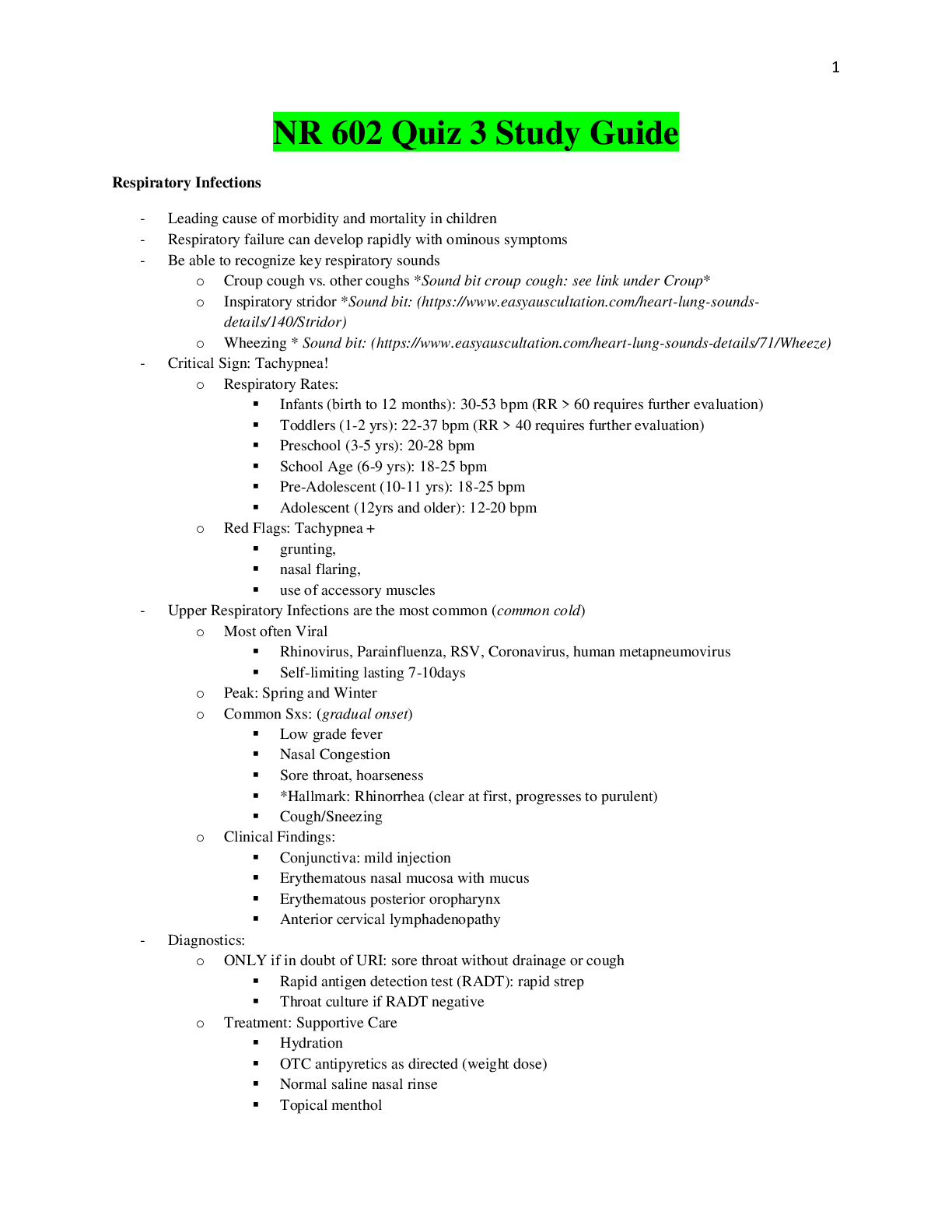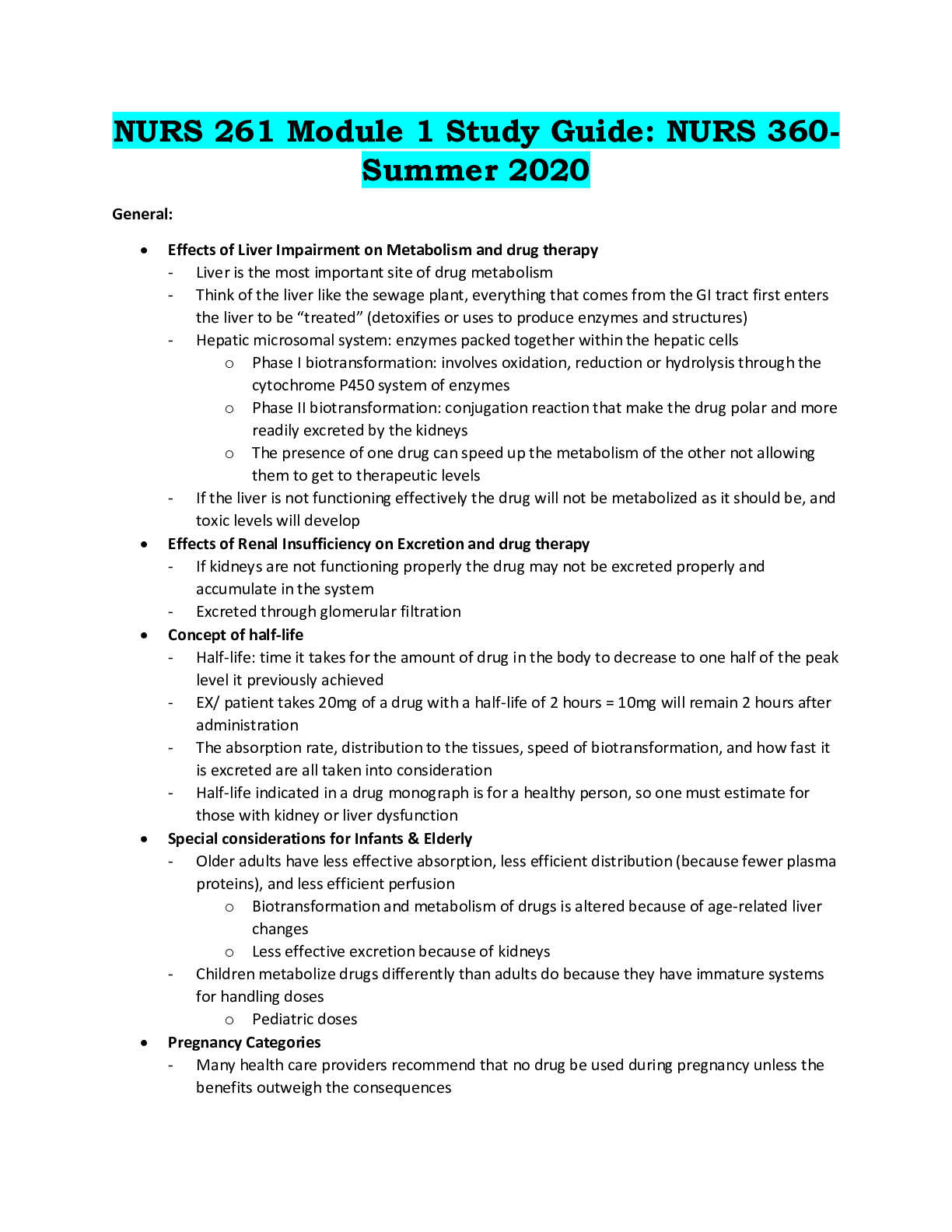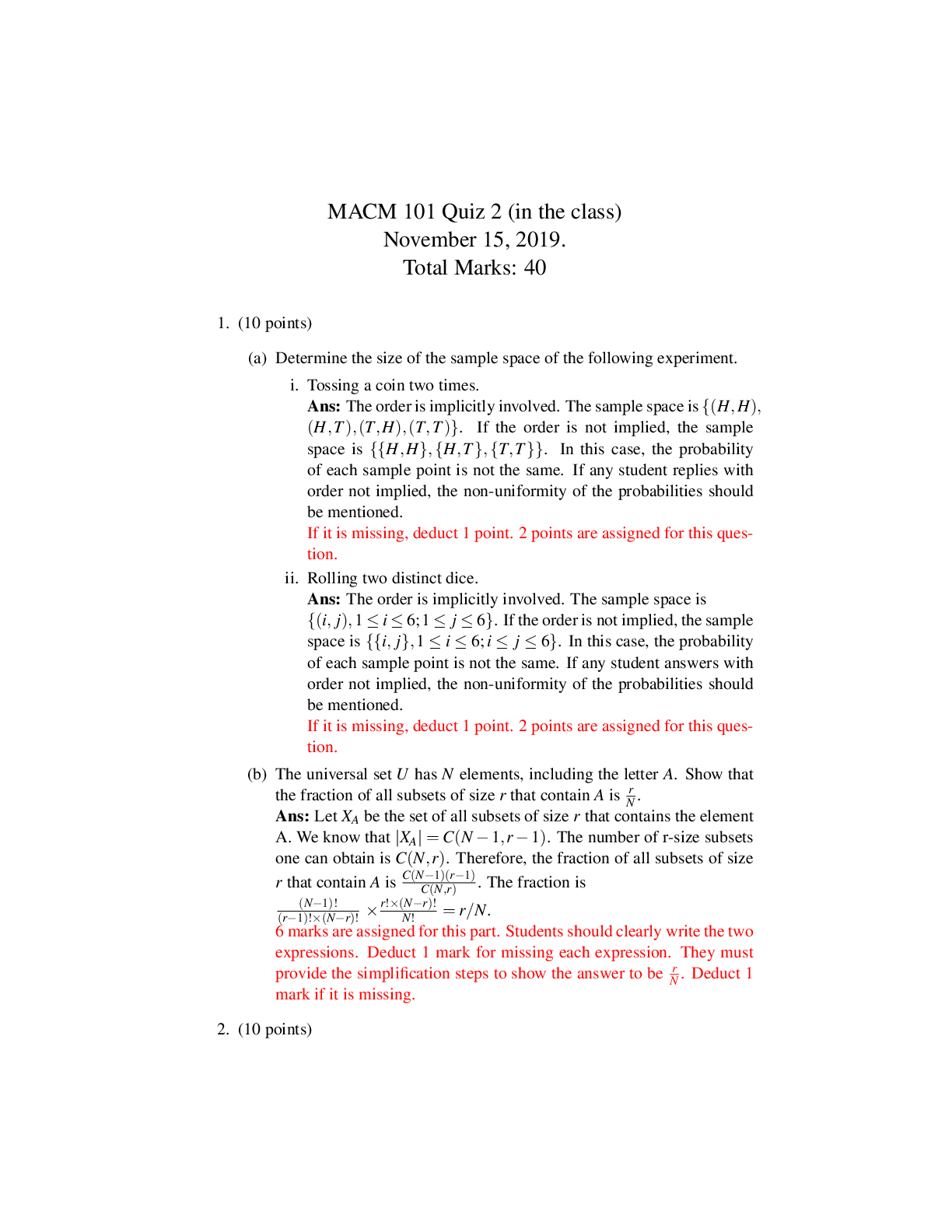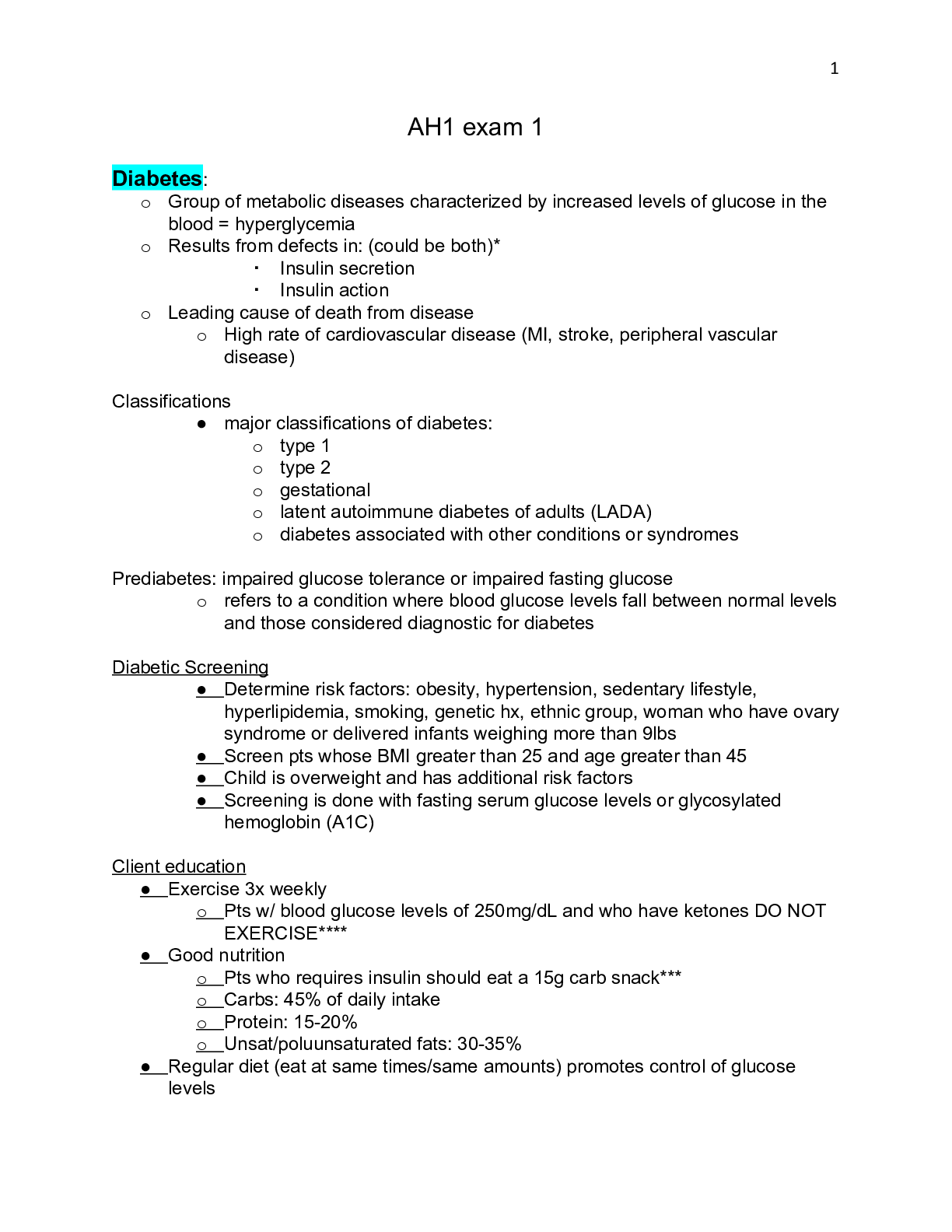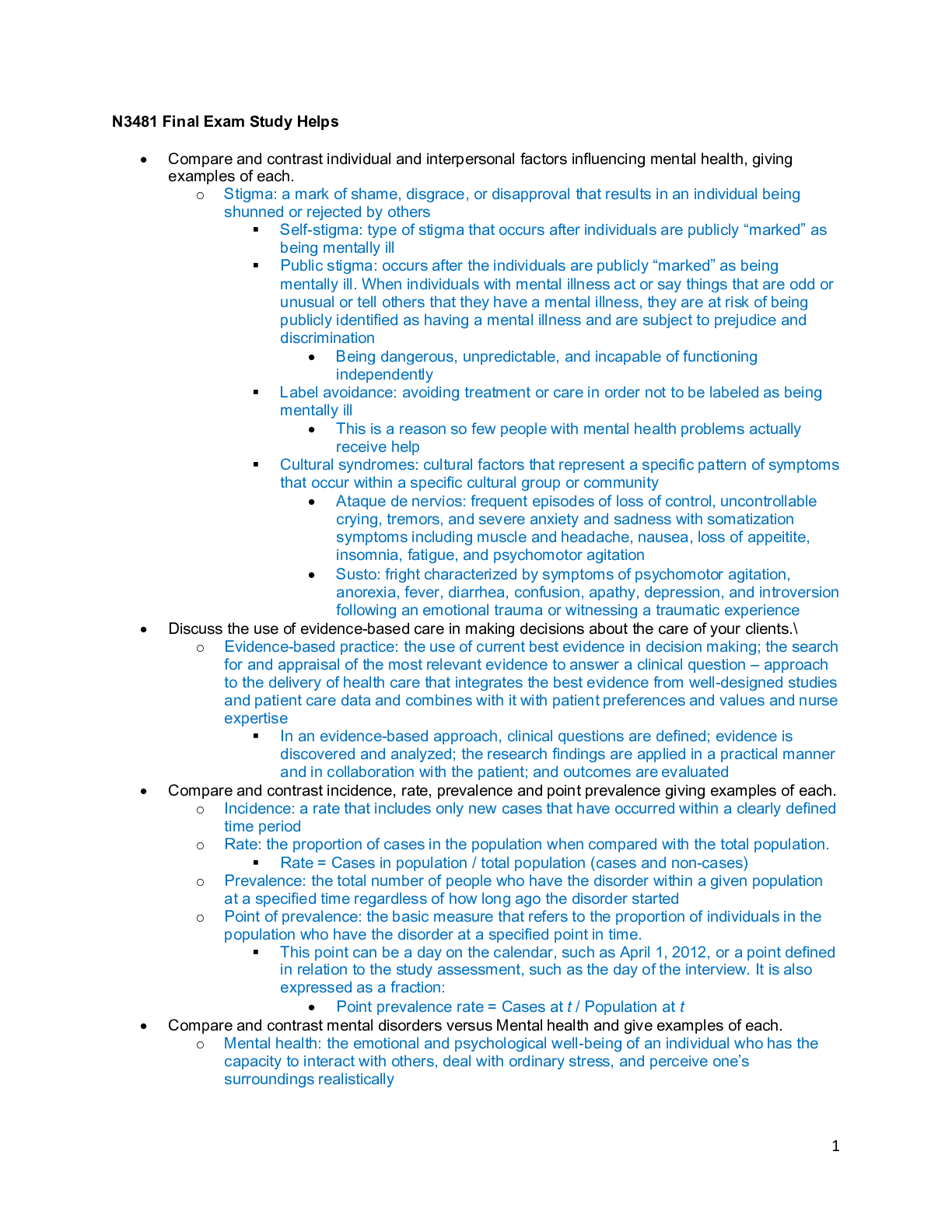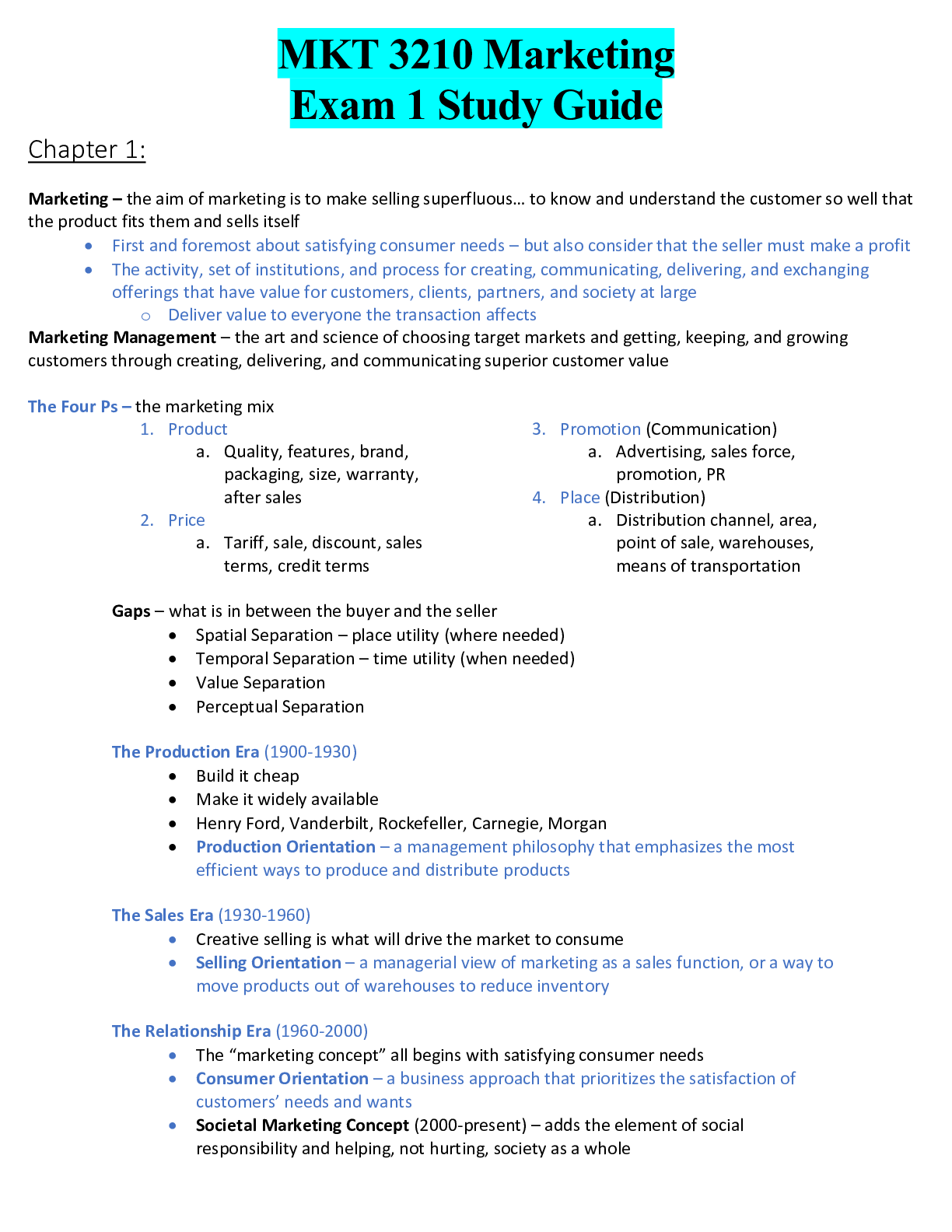*NURSING > STUDY GUIDE > NUR MISC Problems Related to Injuries & High-Risk Behaviors & Burns (All)
NUR MISC Problems Related to Injuries & High-Risk Behaviors & Burns
Document Content and Description Below
NUR MISC Problems Related to Injuries & High-Risk Behaviors & Burns Nursing ACTIONS • Prevent Harm • Respond to Harm • Reintegrate after Harm Levels of Risk • Low • Moderate • Hi... gh • What defines the LEVEL of Risk? Social Determinants • Individual and population health are affected by a range of personal, social, economic, and environmental factors. • Education and addressing social determinants as a means of improving population health Maternal, Infant, & Child Health • Addressing the health needs of women before, during, and after pregnancy helps to improve not only their health but also their children’s health • Healthy birth outcomes and early identification and treatment of health conditions among infants can prevent death or disability and enable children to reach their full potential Nutrition, Physical Activity, & Obesity • Good nutrition, physical activity, and a healthy body weight can help decrease the risk of developing serious health conditions, such as HTN, high cholesterol, DM, heart disease, CVA, and CA. • In addition, to manage existing health conditions • To improve quality of life emphasize following a healthy eating pattern, engaging in regular physical activity, and achieving and maintaining a healthy weight THE CHILD AND TRAUMA Intentional & Unintentional Injuries: Injury and Violence • Intentional and Unintentional injuries: • Homicide • IPV • Child abuse & neglect • School violence • Suicide • MVAs • Unintentional drug overdoses. Unintentional Injury Death • On average, 12,175 children 0 to 19 years of age died each year from an unintentional injury • Males had higher injury death rates almost 2xs • Injuries due to transportation were the leading cause of death for childreno The highest death rates were occupants of motor vehicles in traffic • The leading causes of injury death differed by age group: o For children less than 1 year of age, majority deaths were due to suffocation o Drowning was the leading cause injury death for those 1 to 4 years of age o For children 5 to 19 years of age, the most injury deaths were due to being an occupant in an MVA • Risk for injury death varied by race o Injury death rates were highest for American Indian & Alaska Natives and were lowest for Asian or Pacific Islanders o Overall death rates for Whites and African Americans were approximately the same Unintentional Non-Fatal Injury • Falls are the leading cause of nonfatal injury for children ages 19 and under. • For children less than 1 year of age, falls accounted for over 50% of nonfatal injuries • Nonfatal suffocation rates were highest for those less than 1 year of age • Rates for fires or burns, and drowning were highest for children 4 years and younger • Children 1 to 4 years of age had the highest rates of nonfatal falls & poisoning • Injury rates related to MVAs was highest in children 15 to 19 years of age Common Types of Emergencies in Children • Respiratory arrest • Shock • Cardiac arrhythmias and arrest • Near drowning • Poisoning • Traumatic injury • Poisonings • Bites How to Ask about a Gun… • Having a dialogue about whether or not guns are kept in the home can be beneficial, but parents may feel awkward or uncomfortable bringing up the subject • Make It Part of the History or Assessment. o “‘I ask everyone this question: Is there a gun in your home?“ • It’s About Safety o When discussing guns in the home the emphasis is on safe storage and not ownership • If there is/are gun(s) in their home, how do they safely store the gun o “How is the gun stored – unlocked or locked?” • Ask in a professional and non-judgmental way HEALTH RISK BEHAVIORS • Healthy (NO pre-existing) vs Chronic health issues. • Impact of risk taking on health status, sx management, short term and long-term health outcomes. • Problem = risk behaviors begun in tween/teen years often stay part of the behavior into adulthood. Smoking & ETOH • Levels/reports of health risk behaviors of cigarette smoking are beginning to decrease in healthy adolescents • Cigarette smoking is increasing among youth and adults with chronic health conditions, specifically asthma • Regular ETOH drinking is decreasing BUT Binge drinking is rising rapidly in adolescence Marijuana• Daily marijuana use is now at the highest rate among college students in more than three decades • Half (51%) of all full-time college students today have used an illicit drug at some time in their lives; roughly four in 10 (39%) have used one or more such drugs in just the 12 months preceding the survey Internet Risk behaviors • YouTube Video What the Internet does to the brain: • https://www.youtube.com/watch?v=cKaWJ72x1rI • Clustering of risky behaviors for online behaviors and for offline meetings. • Risky online relationships & Unsafe cyber-dating. • Underlying concerns: o Victimization o IPV o unsafe interactions • Cyber bullying & harassment. Technology • Sexting • Distracted Driving • Cyber bullying • Bullying • Violence • Gang involvement • Commercial sex Mental Health Implications: IAD • Internet Addiction Disorder (IAD), also referred to as Compulsive Internet Use (CIU), Problematic Internet Use (PIU), or iDisorder • IAD is described as a compulsive-impulsive spectrum disorder that involves at least three subtypes: 1) excessive gaming, 2) sexual preoccupations, and 3) e-mail/text messaging IAD is characterized by: 1) Excessive use: often associated w/a loss of sense of time or a neglect of basic drives 2) Withdrawal: including feelings of anger, tension, and/or depression when the computer is inaccessible 3) Tolerance: including the need for better computer equipment, more software, or more hours of use 4) Negative repercussions: including arguments, lying, poor achievement, social isolation, and fatigue Electronic Aggression - Defined • Any behavior performed through electronic or digital media by individuals or groups that repeatedly communicates hostile or aggressive messages intended to inflict harm or discomfort on others. EA Victimization: Signs & SXS • Avoids all devices or appears stressed when receiving a text, e-mail, photo, or IM • Withdraws from family and friends or acts reluctant to attend school and social events • Avoids conversations about internet or social media use. • Exhibits signs of low self-esteem including depression and/or fear • Has declining grades • Has poor eating or sleeping habits Cyberbullying: Questions to ask • Have you ever been upset with someone online? How did you deal with it? • Has someone ever sent you a mean message online? How did it make you feel? • If you knew someone was being cyberbullied, what would you do?• Do you know where to report cyberbullying on the websites and apps you use? Who would you talk to at school? Sexting: Questions to ask • Has anyone ever sent you a sext? • Have you known anyone who sent or received a sext? • Has anyone ever asked or pressured you to sext? • What should someone do if they receive a sext? • What could happen to you if someone forward to you a naked picture? • What are some ways a private photo sent to one person could be seen by others? Texting & Driving • High School students who text while driving are more likely to report: o drinking and driving, o drug use, o electronic aggression. • Relationship with participation in online bullying with boys more likely than girls to report having used the Internet or an instant message (IM) to harass another student Term Definition Internet risk behaviors Individual online risky behavior can be inclusive of more than one behavior and have been found to cluster together include sharing of personal information (e.g., name of school, email address, picture of self); corresponding online with an unknown person or later meeting the person offline; engaging in onlineinitiated harassment (e.g., malicious or offensive jokes); visiting online-initiated sex sites; and overriding Internet filters or blocks. Self-exploitation Self-exploitation, specifically the creating and distributing of explicit or inappropriate pictures of oneself or peers is an emerging high-risk Internet behavior. Also called Auto-pornography. Sexting Involves the sending or forwarding via cell phone sexually explicit photographs or videos of the sender or someone known to the sender. Sextortion Sextortion is a relatively new form of sexual exploitation that occurs primarily online and in which non-physical forms of coercion are utilized, such as blackmail, to acquire sexual content (photos/videos) of an individual, obtain money from that individual or engage in sex with them (National Center for Missing and Exploited Children (2017). Social media Forms of electronic communication (such as websites for social networking and microblogging) through which users create online communities to share information, ideas, personal messages, and other content (such as videos) (Merriam-Webster, 2017). Role of the Nurse Ask questions about Internet or Online behavior: o Time spent online – how much & where o Social networking site membership(s) o Behaviors when online – who are they “chatting with” or meeting online? o Any student with high risk behaviors (e.g. alcohol, smoking, sex, texting & driving) should be screened for online risk behaviors • Know risky behaviors for online and offline meetingsRole of the Nurse • Ask adolescents about family relationships and school experiences as a part of routine health screenings • Encourage Positive Parenting Practices • Engage parents in discussions about how to connect with their adolescents, communicate effectively, and monitor activities and health behaviors • Educate parents and youth about adolescent development and health risks Protective factors • Connectedness Is an Important Protective Factor for Health and Well-being • Connectedness refers to a sense of being cared for, supported, and belonging, and can be centered on feeling connected to school, family (i.e. parents and caregivers), or other important people and organizations in their lives. • Youth who feel connected at school and home are less likely to experience negative health outcomes related to sexual risk, substance use, violence, and mental health • School connectedness (the belief by students that adults and peers in the school care about them as individuals) has been shown to have positive effects on academic achievement & attendance _________BURNS__________ Difference in Skin Between Children and Adults • Infant’s epidermis is thinner and blood vessels are closer to the surface. • Infant loses heat more readily through skin surface. • Allows substances to be absorbed through skin quicker. • Does not reach adult thickness until late teen years. • Infant’s skin contains more water. • Epidermis is loosely bound to the dermis. • Friction may easily cause separation of layers, resulting in blistering or skin breakdown. • Infant’s skin is less pigmented, therefore at risk for UV damage. Pediatric Burn Care NARRATED SLIDES Review Slide - Table 24-6 p 971 A&P of Skin: • What is skin? • What does skin do for a human being? • How important is skin to a human being? • What does skin provide? • What happens when skin is damaged? Risk Factors for Burn Injury Age can be a factor • Children o 1/3 to 1/2 of all hospitalizations for burns are children under 18 years • Elderly o Immobility, sensory problems Burn Statistics • 2012 nearly 127,000 children & more than half (69,000) had significant burns.• Means significant burns occur to about 189 U.S. children a day. • 90% treated in ambulatory setting. • 4% were admitted to the hospital and not transferred • 5.6% were transferred to another hospital • 75 - 90% of burn injuries are preventable Burn Statistics Looking at fatalities: • 334 children ages 19 and under died from fires or burns in 2013. • 87% (291 deaths) were in residential home fires. • 44% of children who died from fires or burns were ages 4 & under • Twice that of 5 to 9-year olds, • Almost four times that of 10 to 14 year olds. Burn Admission Statistics • Gender: 69% male & 31% female • Ethnicity: 59% Caucasian, 19% AA, 15% Hispanic, 7% Other • Admission Cause: 44% fire/flame, 33% scald, 9% contact, 4% electrical, 3% chemical, 7% other • Place of Occurrence: 69% home, 9% occupational, 10% Other, 7% street/highway, 5% Recreational/Sport, Generally speaking, three major sources of burns: • Thermal injuries: o hot liquid, open flame • Electrical injuries o household current or lightening • Chemical injuries o alkaline or acid liquids or powders Burn Classifications • Classifications are dependent on the degree of tissue involved and the total body surface area affected. • Minor • Moderate • Major Assessment – Depth of Burns Old Term 1st degree 2nd degree 3rd degree 4th degree New Term Superficial Partial thickness Deep partial thickness Full Thickness (Tendon bone/muscle involvement)The extent of damage is measured by the depth of the burn. The depth of a burn helps determine how it will be treated. What is SUPERFICIAL? • Superficial burns affect the epidermis layer only • Present as pink & slightly swollen from edema the associated pain is minimal and will often subside as the burn cools • These burns do not blister • These wounds can heal within a week. Assessment: Depth of Burns- Partial-Thickness Partial-thickness burns - Superficial • Affects entire epidermis & some dermis • Painful & Red • Blistered d/t plasma, • Edematous, + bld supply • Healing 7 – 14 days o depends on depth • Occasional scarring Partial-thickness burns - Superficial but deeper: • Pink or Bright red • Moist looking • Very painful • Blisters – blanch with pressure • Heal within 7 – 21 days • Potential for scarringPartial-thickness burns - DEEP • Damage through the epidermis, 2 layers of the dermis • Red/waxy-white appearance • Cap Refill intact • Painful • Broken blisters, weeping • Marked edema • Healing 21 – 35 days • Excessive scaring Assessment – Depth of Burn Full thickness • Full Thickness Presents as: o Epidermis, dermis, all subcutaneous tissue o Eschar – thick leather-like dead skin o Limited pain or painless d/t nerve destruction o Cap refill absent o Can extend into tendons, muscles and bones – electrical burns o Surgical intervention necessary • DEEP Full Thickness Burns involve all layers of the skin and extend into muscle, bone, and tendons. • No skin cells are left for regrowth. o Eschar – thick leather-like dead skin o Can extend into tendons, muscles and bones – electrical burns o Surgical intervention necessary o Amputations may be necessary. Assessment – Extent of Burn • Total Body Surface Area (TBSA) – • The size of the burn matters & location of the burn. • Based on charts • Rule of Nines • Lund-Browder body chart • Other charts available and used based on hospital • Calculation of TBSA is essential for fluid resuscitation Assessment – Extent of Burn with Rule of Nines"Rule of Nines" chart is used to determine the total body surface area (TBSA) that has been burned and to evaluate fluid loss. The chart divides the body into 11 areas, each accounting for 9% of the total body area, and a 12th area representing the 1% of body surface occupied by the genitals. The “rule of nines” used in adults may be used only in children older than age 14 yr or as a very rough estimate to institute therapy before transfer to a burn center. The patient has a large burned area on the right arm. The burned area appears pink, has two small blisters, and is very painful. How should the nurse categorize this burn wound? a. superficial b. partial thickness (superficial) c. partial thickness (deep) d. full thickness The characteristics of the wound best fits a superficial partial thickness. Blisters are not seen with full thickness or superficial and rarely with deep partial thickness burns. Burn Phases • The care of a major burn is organized into 3 OVERLAPPING stages: o Emergent (resuscitative) o Acute (wound healing) o Rehabilitative (restorative)Nursing Role & EBP Nursing care must focus on: • Airway and Respiratory Management • Fluid Resuscitation • Wound Care • Pain Management THROUGHOUT the 3 OVERLAPPING stages: Emergent (resuscitative), Acute (wound healing), Rehabilitative (restorative) Assessment Assessment MUST include: • Presence of associated injuries • Pre-existing &/or chronic health conditions • Medications • Allergies • LOC & psychological health • Social concerns • Need to check for other problems – falls, broken bones, head injuries, etc. • Social problems – typical, plus for house fires – anyone else in family injured, killed? Condition of house? Severity of injury can be influenced by: • Age • Past Medical history – why? • What caused the injury and how • Depth of tissue damage • Percentage of body surface area Nursing Interventions for Children with Extensive Burns • Promoting oxygenation and ventilation • Restoring and maintaining fluid volume • Preventing hypothermia • Cleansing the burn • Preventing infection • Managing pain with atraumatic care • Treating infected burns • Providing burn rehabilitation Location & Nursing Role • Location – Hospital or Pre-Hospital or Rehab? • Home, clinic, school, outdoors, ?? • What has happened? • Witness, in-hospital – ED, ICU, Floor • Who is involved? • Family, bystanders, EMS, team? Emergent Phase • Phase begins with the onset of burn injury and lasts until the completion of fluid resuscitation or a period of about the first 24hrs.• Priorities include: o Adequate airway o Tx burn shock o Care for area or site of burn injury • Different responses are based on type of burn – Sunburn (superficial) (minor) fluid resuscitation is very, very different than a major full thickness burn. Treatment • Initial first aid: o STOP THE BURNING!! • Cool the burn: o Dissipation of heat o Decrease in pain • NO ICE!! • Remove Clothing & jewelry Assessment • Assess Vital Signs: RR, HR & BP • Assess Cap Refill • Assess Mental Status • Assess Lab Values: o CBC, Electrolytes, Glucose, BUN/Creatinine, ABGs, UOP, o Carboxyhemoglobian o Carbon Monoxide can be an immediate threat to life b/c binds to HGB with an affinity of 200x greater than O2 resulting in tissue hypoxia. Respiratory Management • Airway! • Patency of airway – establish/maintain prn • Obstructions? Edema? • Pulmonary complications [esp in emergent phase] – major cause (85%) of death in thermal burns • Anticipate respiratory involvement o Who is at risk? • Initially, focus on ABC’s. Easy to get distracted by sight of burn o Is there upper airway edema? History- • Pt unconscious or AAOx3 • Noxious Chemicals Involved – closed space…. • What do you see? o Singed nasal hares o Facial Burns o Hoarse voice o Brassy cough Respiratory Treatment • Depends on Airway status: o O2 with humidification - may start at high level o Intubation and on ventilator• Resp Rate & Pulse Oximetry • CXR • ABGs • Frequent Respiratory assessments • Inclusion of Respiratory therapy • Emergent = Intubation in major or moderate burns, O2 • Acute = be alert for PN Cardiovascular Assessment • Cardiac o What is cardiac risk in pediatric population? o Hypovolemia and Shock d/t circulatory issues? • Dysrhythmias • Circulatory impairment o A&P changes w/blood viscosity Cardiovascular Treatment • Heart rate & rhythm o BP o ECG – what does it show • What is child’s risk for heart failure? • Assess Lab Values: o CBC, Electrolytes, Glucose, BUN/Creatinine, ABGs, UOP Treatment: Circulation • Fluid resuscitation is most important for all burns especially Major & Moderate surface area ones. • Route: PO if < 10% TBSA and is able to drink & maintain. • Route: IV if > 10% TBSA • Regulate the fluid balance, maintain the pt’s temp and avoid infection. Treatment: Circulation • Fluid Resuscitation o Impaired capillary permeability o Extensive edema 0 – 4 days o Prevention of hypovolemic shock o Goal – infuse IV fluids to compensate for fluid loss o Will often require massive amounts of fluid. o BE CAREFUL OF OVERLOAD o Because of interstitial edema and sequestration of fluid in muscle cells, patients may gain up to 20% over baseline pre-burn body weight Treatment: Circulation • Fluid Resuscitation o Various formulas used as guidelines o Each formula is based on body weight and TBSA o Generally the formula involves mL/kg X TBSA o Adequacy of resuscitation based on child’s response Urine output Stable VS Alert and oriented Parkland formula: • 4 mLs X kg of body weight X TBSA o 1/2 of total given over first 8 hours post-burn o 1/4 of total given over second 8 hours post-burn o 1/4 of total given over third 8 hours post-burn • Parkland formula – example • Patient weighs 15 kgs., 45% TBSA burn o 4mLs X 15 kgs X 45 TBSA = 2700mL 1st 8 hours = 1350mL (168.8mL/hour) 2nd 8 hours = 675mL 3rd 8 hours = 675mL Fluids • Decrease IV fluids after capillary permeability regained. • Monitor UOP – what should it be?? o At least 1mL/kg in children under 30kg o 30mL or greater in older children • Monitor hemodynamic status to avoid overload • Maintenance fluids o Prevent fluid overload o Prevent pulmonary edema Treatment: Pain • Pain Management of Major/moderate Burns o Initially – IV (e.g. morphine) o Use IV route – fluid shifts limit absorption from SC and IM areas o Tylenol for minor burns o Use appropriate assessment tools o Medicate before any procedures o PCA o Behavioral interventions= imagery, relaxation, hypnosis o Respiratory depression – not if medicated appropriately o Morphine, fentanyl (Sublimaze) and midazolam (Versed) are the most commonly used agents The mother of a child with a burn injury shares the following hx of previous health problems. Which one should alert the nurse to the need for alternation of the fluid resuscitation plan? a) Has seasonal asthma b) Had repair for cleft palate c) Had repair for transposition of great arteries d) Report of kidney stones within the last 6 months The cardiac history suggests that the child may have a diminished CO as a result of the TGA and would be at greater risk for the development of CHF and pulmonary edema during fluid resuscitation. Complications Treatment - Wound Care• Begins on DAY 1 • Aseptic technique o Various methods o When to transition to clean technique? Wound Care • Prevent Infection or Sepsis • Hand hygiene • NO shared equipment • Shower daily (if appropriate) • Dressing change, 2x a day (typically) o Remove old dsg with ? o Apply new dsg with ? • Keep room warm at 85 degrees • Keep wound covered Preparation for Dressing Change: ORDERS • Topical Agent o Silvadene (AgSD)- no face o Bactroban o Neosporin o Polysporin o bacitracin o Xeroform o Aqua cel Ag • Pain Medications o IV vs Oral Acetaminophen NSAIDS Opioids [?] Anesthesia • Therapy (OT, PT, CLS) Skin Grafts & Donor Sites • Skin grafting is a surgical procedure by which skin or skin substitute is placed over a burn or non-healing wound to permanently replace damaged or missing skin • The grafting serves 2 purposes: o reduce the course of treatment needed (and time in the hospital) o improve function & appearance of the area of the body which receives the skin graft o Grafts must be watched for s&s of Infection, bleeding and protected shearing • Nursing care: Wound care & frequent observations with daily assessment for signs and symptoms of infection • Once a skin graft has been put in place surgically, it must be maintained carefully • For full thickness skin grafts the surgical dressing will remain in place, untouched and unchanged, for 5 to 7 days. Wound Care: Cleansing Debridement • Remove the dead tissue or skin from wound area to encourage healing • Sometimes under general anesthesia or sedation - Usually a procedure completed by a physician in OR • What method is being used – open, close, sterile or clean Patient care team - Goals During Dressing Change • Range of motion (ROM) assessment with dressings off (check for blanching) • PROM & AROM exercises with the dressings off • Identify positioning for dressings and splint application • Take photos of wounds and scars to document progressPositioning • Goals for Positioning o Edema Control o Prevent subsequent pressure ulcers o Maintain elongation of soft tissues • Consider the following: o Elevate extremities o Turning schedule o Specialty bed o Protect bony prominences Who Needs Compression? • Any burns healed in under 10 days do not need compression • Compression always used after full thickness burns or any burns requiring grafting • Any person who has a history of forming hypertrophic or keloid scars • Compression o Prevent formation of contractures o Minimize scarring o Provide continuous and uniform pressure o Worn 23 hours per day o Worn for 18 months to 2 years Rehabilitative Phase • Last phase • Technically begins with the closure of the burn and ends when the child has reached the optimal level of functioning • Really BEGINS on DAY #1 • Emergent & Intermediate phase focus on establishing and maintaining physiological equilibrium • Rehab phase = return to pre-injury ADLs IMPORTANT Areas for Consideration & Assessment Psychological support • Play therapy and play time o What is the difference? • Counseling – individual and family o Caregiver support o Self-image immediately post-burn and long-term • Long term for patient and family • PTSD, even with what seems a minor burn Nutritional support • Burned child requires 2 – 3 times the normal amount of calories in order to heal • Also need normal calories for growth • Major burns – will require parenteral and enteral supplements Family Concerns • Family Strengths and Resourceso Other family members involved? o Loss of home? o Long term, chronic nature of injury o Dealing with multiple family members injured, possible deaths- cases where one child responsible for fire – others TYPES OF BURNS • Radiation • Sunburn o Length of time in sun o Time of day o Age of child o Use of sunscreen o The longer in the sun the more likely to burn o 10 am to 2pm most burning o The younger the child, faster the burn o Sunscreen – spf factor, when was it applied, how often, etc. • Tanning booths • X-rays or radiology • Nuclear exposure • Ionizing radiation can produce tissue damage directly e.g. sunburn but radiation therapy can go deeper at molecular level Thermal Burns • result from contact with hot substances that cause cell injury: o Flame o Hot Liquids (H2O, cooking oils, grease, etc.) o Hot solid objects (solid metal, hot plastic, glass, etc.) Electrical • Household o Chewing electrical wires o Inserting objects into electric sockets • Lightning • Extensive damage can appear: o Several days to weeks • Bones, mm, tendons, and fat do not always conduct electricity, in many cases they respond by producing heat • Most injuries occur to mm surrounding the long bones (which can be fractured due to current voltage) Chemical • Destroy tissue and continue to do damage up to 72 hours unless neutralized. • Ingestion of caustic agents – examples?? • Exposure to caustic agents • Explosions Inhalation and Smoke Burns • Often occur concurrently with thermal or chemical burns • If thermal burns:o Inhalation = facial burns, hoarseness, soot, lip edema, singed eyebrows or nasal hairs • Requires immediate respiratory interventions – bronchoscopy, ET intubation, and measurement of COHbg _____COLD INJURY_____ • Chilblain o Redness/swelling especially of hands o Vasodilation, edema, bluish patches, itching and burning; o Symptoms frequently continue after re-warming but most usually resolve in a few days • Frostbite o Tissue damage due to ice crystals in tissues o Blisters appear 24 to 48 hours after re-warming o Treatment of blisters Child Abuse • History of burn o inconsistent? o incompatible with child’s abilities? • Unclear history • Delay in seeking treatment • Conflicting stories Child Abuse • Certain types of burns o Immersion burns o Doughnut shaped burns on buttocks o Cigarette burns o Iron marks Overall Treatment: Summary • First priority: ABC’s & type of burn • Assessment & History • PAIN Assessment & Management • Treatments & Wound Dressing care • Medications – Short-term & Long-term • Rehab needs & Level of function • Psychological or emotional needs o Child, family, caregivers • Nutritional needs YouTube Videos Watch and Listen to these stories about children with major burns and their recovery – think about G&D, family, support, etc. (please be aware that these are marketing videos but still provide information) • https://www.youtube.com/watch?v=IqdT1hfZBl0 • Zoni • https://www.youtube.com/watch?v=u11nO_3Hhvc • DeJae at Hopkins [Show More]
Last updated: 2 years ago
Preview 1 out of 18 pages

Buy this document to get the full access instantly
Instant Download Access after purchase
Buy NowInstant download
We Accept:

Reviews( 0 )
$10.00
Can't find what you want? Try our AI powered Search
Document information
Connected school, study & course
About the document
Uploaded On
May 16, 2021
Number of pages
18
Written in
Additional information
This document has been written for:
Uploaded
May 16, 2021
Downloads
0
Views
117

